Black shale Mo isotope record reveals dynamic ocean redox during the Mesoproterozoic Era
Affiliations | Corresponding Author | Cite as | Funding information- Share this article





-
Article views:160Cumulative count of HTML views and PDF downloads.
- Download Citation
- Rights & Permissions
top
Abstract
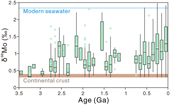
Figures
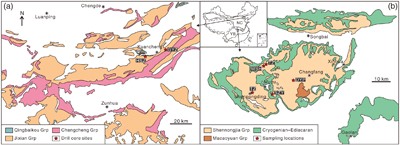 Figure 1 Maps showing the Proterozoic outcrops in the (a) Yanliao and (b) Shennongjia regions. Sampling locations are marked as stars. Formations: GYZ, Gaoyuzhuang; HSZ, Hongshuizhuang; DYP, Dayanping; TZ, Taizi; WSH, Wenshuihe; SZY, Songziyuan. | 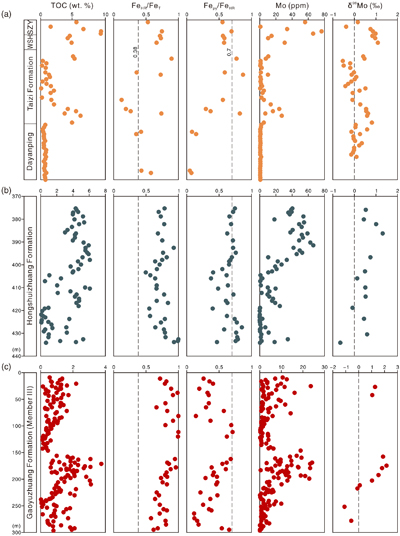 Figure 2 Geochemical profiles for shales from the (a) Shennongjia Group, (b) Hongshuizhuang Formation, and (c) Gaoyuzhuang Formation (Member III). The TOC and Mo contents of the Shennongjia Group are compiled from Canfield et al. (2018). Note that the Shennongjia samples are plotted sequentially and relative to stratigraphic position, but not as a function of depth. | 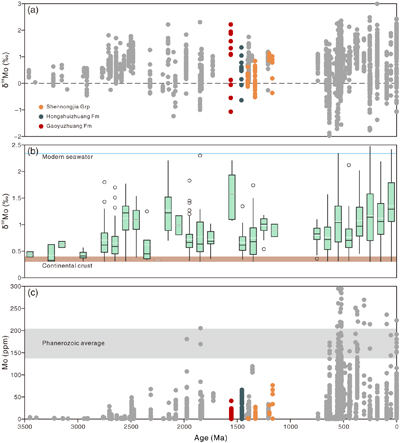 Figure 3 Black shale Mo record. (a) Mo isotope ratios from the Palaeoarchean to present. (b) Filtered data in 100 million year bins, focusing on samples with δ98Mo greater than the continental crust composition (>0.3 ‰). The Box and Whisker plots show the first quartile, mean (white lines), median (black lines), third quartile, and outliers of the data. (c) Mo concentrations through time. | 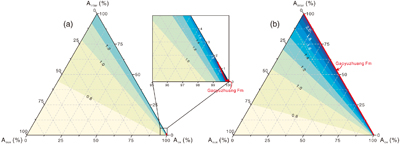 Figure 4 Estimates of ocean redox through the Mo isotope mass balance model, where Aox, Ainter, and Aeux denote the seafloor areas of oxic, intermediate reducing, and strongly euxinic conditions, respectively. The left panel (a) is based on a fractionation of 0.7 ‰ for the intermediate sink, while the right panel (b) employs a larger fractionation of 1.5 ‰ for this sink. |
| Figure 1 | Figure 2 | Figure 3 | Figure 4 |
top
Introduction
The Mesoproterozoic Era has been described as a time of climatic, geochemical, and biological stasis. The relatively small carbonate carbon isotope variations and the absence of continental ice sheets contrast starkly with the following Neoproterozoic Era when low latitude glaciations and huge carbon isotope excursions were prevalent. Neoproterozoic marine environments also witnessed the diversification of eukaryotic phytoplankton and animals, which have long been linked to the surface oxygenation, while low oxygen availability in Mesoproterozoic oceans may have limited eukaryotic diversity and organismal complexity, generating a sluggish biosphere (Anbar and Knoll, 2002
Anbar, A.D., Knoll, A.H. (2002) Proterozoic ocean chemistry and evolution: A bioinorganic bridge? Science 297, 1137–1142.
). This traditional view, however, is evolving with a growing amount of newly reported Mesoproterozoic fossils, such as the filamentous and lobate fossils, interpreted as probable crown group red algae, in the ∼1600 Ma Tirohan Dolomite of central India (Bengtson et al., 2017Bengtson, S., Sallstedt, T., Belivanova, V., Whitehouse, M. (2017) Three-dimensional preservation of cellular and subcellular structures suggests 1.6 billion-year-old crown-group red algae. PLoS Biology 15, e2000735.
) and the ∼1560 Ma Gaoyuzhuang carbonaceous compressions closely resembling modern benthic algae (Zhu et al., 2016Zhu, S., Zhu, M., Knoll, A.H., Yin, Z., Zhao, F., Sun, S., Qu, Y., Shi, M., Liu, H. (2016) Decimetre-scale multicellular eukaryotes from the 1.56-billion-year-old Gaoyuzhuang Formation in North China. Nature Communications 7, 11500.
).If we accept the notion that life has evolved with the environment, then these biological innovations should be considered together with the redox changes in Mesoproterozoic oceans. Indeed, existing data show that Mesoproterozoic deep waters had variable redox chemistry ranging between oxic, euxinic (sulfidic), and ferruginous conditions (Wang et al., 2017
Wang, X., Zhang, S., Wang, H., Bjerrum, C.J., Hammarlund, E.U., Haxen, E.R., Su, J., Wang, Y., Canfield, D.E. (2017) Oxygen, climate and the chemical evolution of a 1400 million year old tropical marine setting. American Journal of Science 317, 861–900.
). Within the context of deep ocean redox fluctuations, there is a broad debate on atmospheric oxygen levels. Some studies have advocated very low concentrations of 0.1–1 % PAL (present atmospheric level; Planavsky et al., 2020Planavsky, N.J., Reinhard, C.T., Isson, T.T., Ozaki, K., Crockford, P.W. (2020) Large mass-independent oxygen isotope fractionations in mid-Proterozoic sediments: Evidence for a low-oxygen atmosphere? Astrobiology 20, 628–636.
), yet others provided evidence for minimum values of 1–4 % PAL (Zhang et al., 2016Zhang, S. et al. (2016) Sufficient oxygen for animal respiration 1,400 million years ago. Proceedings of the National Academy of Sciences 113, 1731–1736.
; Canfield et al., 2018Canfield, D.E., Zhang, S., Frank, A.B., Wang, X., Wang, H., Su, J., Ye, Y., Frei, R. (2018) Highly fractionated chromium isotopes in Mesoproterozoic-aged shales and atmospheric oxygen. Nature Communications 9, 1–11.
).To develop and test these ideas, we present total organic carbon (TOC), Fe speciation, Mo abundance and isotopic compositions (denoted as δ98MoNIST3134=0.25; Nägler et al., 2014
Nägler, T.F., Anbar, A.D., Archer, C., Goldberg, T., Gordon, G.W., Greber, N.D., Siebert, C., Sohrin, Y., Vance, D. (2014) Proposal for an international molybdenum isotope measurement standard and data representation. Geostandards and Geoanalytical Research 38, 149–151.
) of shale samples from Mesoproterozoic strata spanning from ∼1560 to ∼1170 Ma. Our results, combined with published data, comprise the most comprehensive current Mo isotope record of Mesoproterozoic marine settings and a valuable window into state of ocean redox.top
Geological Background and Samples
Samples were obtained from two drill cores in the Yanliao Basin, North China (the Gaoyuzhuang and Hongshuizhuang Formations) and from multiple outcrops of the Shennongjia Group, South China (Fig. 1). The Gaoyuzhuang Formation is composed of predominately carbonate rocks, and it can be divided into four lithological members (Shang et al., 2019
Shang, M., Tang, D., Shi, X., Zhou, L., Zhou, X., Song, H., Jiang, G. (2019) A pulse of oxygen increase in the early Mesoproterozoic ocean at ca. 1.57–1.56 Ga. Earth and Planetary Science Letters 527, 115797.
). Our study focuses on Member III, where organic-rich calcareous shales were deposited in a relatively deep water environment. Based on zircon U–Pb ages, the time frame of Member III is constrained to ∼1580–1560 Ma (Tian et al., 2015Tian, H. et al. (2015) Zircon LA-MC-ICPMS U-Pb dating of tuff from mesoproterozoic Gaoyuzhuang Formation in Jixian County of North China and its geological significance. Acta Geoscientica Sinica 36, 647–658 (in Chinese with English abstract).
). Above the Gaoyuzhuang Formation, thick bedded dolostones of the Yangzhuang and Wumishan Formations make up the majority of the Jixian Group in North China. Subsequent transgression promoted the offshore deposition of the Hongshuizhuang shales. No radiometric dating has been conducted for the Hongshuizhuang Formation itself, but U–Pb ages of ∼1480 and ∼1440 Ma were reported from the underlying Wumishan Formation and the overlying Tieling Formation, respectively (Li et al., 2014Li, H., Su, W., Zhou, H., Xiang, Z., Tian, H., Yang, L., Huff, D.W., Ettensohn, R.F. (2014) The first precise age constraints on the Jixian System of the Meso- to Neoproterozoic Standard Section of China: SHRIMP zircon U-Pb dating of bentonites from the Wumishan and Tieling formations in the Jixian Section, North China Craton. Acta Petrologica Sinica 30, 2999–3012 (in Chinese with English abstract).
).
Figure 1 Maps showing the Proterozoic outcrops in the (a) Yanliao and (b) Shennongjia regions. Sampling locations are marked as stars. Formations: GYZ, Gaoyuzhuang; HSZ, Hongshuizhuang; DYP, Dayanping; TZ, Taizi; WSH, Wenshuihe; SZY, Songziyuan.
The Shennongjia Group in the northern margin of the Yangtze Block has been explored geochemically for TOC, trace metals, and Cr isotopes (Canfield et al., 2018
Canfield, D.E., Zhang, S., Frank, A.B., Wang, X., Wang, H., Su, J., Ye, Y., Frei, R. (2018) Highly fractionated chromium isotopes in Mesoproterozoic-aged shales and atmospheric oxygen. Nature Communications 9, 1–11.
). Our samples for Mo isotope analysis were collected from the Dayangping, Taizi, Wenshuihe, and Songziyuan Formations. Organic-rich sediments of the latter three formations are enriched in redox sensitive elements, similar to other Mesoproterozoic black shales (Canfield et al., 2018Canfield, D.E., Zhang, S., Frank, A.B., Wang, X., Wang, H., Su, J., Ye, Y., Frei, R. (2018) Highly fractionated chromium isotopes in Mesoproterozoic-aged shales and atmospheric oxygen. Nature Communications 9, 1–11.
). The base of the Shennongjia Group is estimated at ∼1400 Ma, while the uppermost layers deposited after ∼1100 Ma (see Canfield et al., 2018Canfield, D.E., Zhang, S., Frank, A.B., Wang, X., Wang, H., Su, J., Ye, Y., Frei, R. (2018) Highly fractionated chromium isotopes in Mesoproterozoic-aged shales and atmospheric oxygen. Nature Communications 9, 1–11.
, for detailed stratigraphic and chronological descriptions).top
Results
Our geochemical data are illustrated in Figure 2 (see Supplementary Information for methods). Ratios of FeHR/FeT are relatively high (>0.38) in the Gaoyuzhuang and Hongshuizhuang Formations, but vary markedly through shales of the Shennongjia Group. Note that the Shennongjia samples are plotted sequentially by number and relative to stratigraphic position, instead of exact depth, thus the FeHR/FeT variation does not necessarily reflect secular change. For samples with FeHR/FeT > 0.38, their Fepy/FeHR ratios are generally <0.7, while instances of elevated Fepy/FeHR (>0.7) exist in the Hongshuizhuang and Taizi Formations. Molybdenum isotope values range from −1.07 ‰ to +2.21 ‰ for the Gaoyuzhuang Formation, from −0.64 ‰ to +1.35 ‰ for the Hongshuizhuang Formation, and from −0.52 ‰ to +1.12 ‰ for the Shennongjia Group. The heaviest measured δ98Mo in the Gaoyuzhuang sediments coincides with enriched TOC and Mo contents, as well as a positive swing of the Fepy/FeHR profile.

Figure 2 Geochemical profiles for shales from the (a) Shennongjia Group, (b) Hongshuizhuang Formation, and (c) Gaoyuzhuang Formation (Member III). The TOC and Mo contents of the Shennongjia Group are compiled from Canfield et al. (2018)
Canfield, D.E., Zhang, S., Frank, A.B., Wang, X., Wang, H., Su, J., Ye, Y., Frei, R. (2018) Highly fractionated chromium isotopes in Mesoproterozoic-aged shales and atmospheric oxygen. Nature Communications 9, 1–11.
. Note that the Shennongjia samples are plotted sequentially and relative to stratigraphic position, but not as a function of depth.top
Molybdenum Isotopes as a Palaeoredox Proxy
Molybdenum isotopes are a well established proxy used to reconstruct marine redox state. In modern oxygenated oceans, the isotopically heavy seawater Mo signal (∼2.34 ‰) mainly results from Mo uptake onto Mn oxide particles that preferentially adsorb light Mo isotopes (Δ98MoSW−Mn-ox = ∼3 ‰; Siebert et al., 2003
Siebert, C., Nägler, T.F., von Blanckenburg, F., Kramers, J.D. (2003) Molybdenum isotope records as a potential new proxy for paleoceanography. Earth and Planetary Science Letters 211, 159–171.
; Barling and Anbar, 2004Barling, J., Anbar, A.D. (2004) Molybdenum isotope fractionation during adsorption by manganese oxides. Earth and Planetary Science Letters 217, 315–329.
). By contrast, in euxinic basins (often hydrographically restricted today), especially when [H2S]aq exceeds 11 μM (Erickson and Helz, 2000Erickson, B.E., Helz, G.R. (2000) Molybdenum(VI) speciation in sulfidic waters: Stability and lability of thiomolybdates. Geochimica et Cosmochimica Acta 64, 1149–1158.
), Mo is efficiently removed from solution into sediments. Molybdenum isotopes of these sediments can reach isotopically heavy values close to open ocean seawater values (Neubert et al., 2008Neubert, N., Nägler, T.F., Böttcher, M.E. (2008) Sulfidity controls molybdenum isotope fractionation into euxinic sediments: Evidence from the modern Black Sea. Geology 36, 775–778.
). Such a near quantitative Mo transfer allows the use of euxinic deposits to infer seawater Mo isotope compositions. For sediments bathed under anoxic but non-euxinic or low [H2S]aq-containing waters, a wide range of δ98Mo is observed (with a preferential retention of light mass Mo isotopes in sediments), likely reflecting the non-quantitative trapping of dissolved Mo and complexation of Mo with metal oxides or organic matter (Kendall et al., 2017Kendall, B., Dahl, T.W., Anbar, A.D. (2017) The stable isotope geochemistry of molybdenum. Reviews in Mineralogy and Geochemistry 82, 683–732.
).The proportion of Fe among its geochemically reactive phases can be indicative of the redox chemistry directly above the accumulating sediments. The majority of our samples possess FeHR/FeT > 0.38 but Fepy/FeHR < 0.7 or slightly >0.7, defining deposition under ferruginous to intermittently euxinic environments (Fig. 2; Poulton and Canfield, 2011
Poulton, S.W., Canfeld, D.E. (2011) Ferruginous conditions: A dominant feature of the ocean through Earth’s history. Elements 7, 107–112.
). Since [H2S]aq strongly affects the removal of Mo, it is likely that low [H2S]aq would have imparted an isotope fractionation during Mo burial. Accordingly, our measured δ98Mo values may provide a minimum constraint on coeval seawater composition. In addition, the low Feox/FeHR ratios of core materials and finely distributed pyrites under scanning electron microscope suggest a minor influence of post-depositional alternation (Supplementary Information).top
Mesoproterozoic Molybdenum Record from Black Shales
In order to investigate the evolution of marine oxygenation, we compare our results with published δ98Mo data over geological time (Fig. 3). Our compilation reveals broad changes in global ocean redox during the Mesoproterozoic Era. Moderate δ98Mo values (<1.35 ‰), including samples from the Hongshuizhuang Formation and Shennongjia Group, dominate the Mesoproterozoic shale record, but excursions to higher δ98Mo values are observed in the Gaoyuzhuang (δ98Momax = 2.21 ‰) and Xiamaling Formations (∼1400 Ma, δ98Momax = 1.74 ‰; Diamond et al., 2018
Diamond, C.W., Planavsky, N.J., Wang, C., Lyons, T.W. (2018) What the ∼1.4 Ga Xiamaling Formation can and cannot tell us about the mid-Proterozoic ocean. Geobiology 16, 219–236.
). On the basis of Mo isotope systematics, such heavy δ98Mo values would require substantial sinks for isotopically light Mo on the seafloor. Does this mean that the ocean was at least temporarily well oxygenated during the Mesoproterozoic? We argue that these data should be interpreted cautiously and with considerations of the contemporaneous marine Mo inventory. It is expected that a well oxygenated ocean would be characterised by heavy seawater δ98Mo and a large dissolved Mo reservoir (and correspondingly enhanced Mo enrichments in the few anoxic regions). We note, however, that in the Gaoyuzhuang Formation highly elevated δ98Mo values occur at Mo concentrations that are much lower than Phanerozoic equivalents (Fig. 3).
Figure 3 Black shale Mo record. (a) Mo isotope ratios from the Palaeoarchean to present. (b) Filtered data in 100 million year bins, focusing on samples with δ98Mo greater than the continental crust composition (>0.3 ‰). The Box and Whisker plots show the first quartile, mean (white lines), median (black lines), third quartile, and outliers of the data. (c) Mo concentrations through time.
The low Mo concentrations may be partly attributed to the calcareous and ferruginous nature of our Gaoyuzhuang samples. Alternatively, the elevated δ98Mo values need not have been associated with the same extent of seafloor oxygenation as today. That is to say, if some intermediate redox sinks could scavenge isotopically light Mo, but with relatively high burial efficiency, elevated δ98Mo values could have accompanied sedimentary Mo concentrations lower than those found in the Phanerozoic (Asael et al., 2018
Asael, D., Rouxel, O., Poulton, S.W., Lyons, T.W., Bekker, A. (2018) Molybdenum record from black shales indicates oscillating atmospheric oxygen levels in the early paleoproterozoic. American Journal of Science 318, 275–299.
). In the following section, we explore this scenario mathematically through the ocean Mo mass balance model.top
Model for Marine Redox Distribution
At steady state, the marine Mo input flux is balanced by removal into oxic, strongly euxinic, and intermediate (mildly reducing, including oxygen minimum zones, ferruginous waters, and other low oxygen or intermittently euxinic settings) sinks. Of all the fractionations involved, those related to the intermediate sink are the least well constrained, yet an empirical fractionation of 0.7 ‰ is commonly chosen for this sink (Kendall et al., 2017
Kendall, B., Dahl, T.W., Anbar, A.D. (2017) The stable isotope geochemistry of molybdenum. Reviews in Mineralogy and Geochemistry 82, 683–732.
). With this isotope offset, a seawater δ98Mo of 2.21 ‰, as we suggest for Member III of the Gaoyuzhuang Formation, can only be achieved with modern-like ocean oxygenation (or nearly so; Fig. 4). However, the magnitude of Mo isotope fractionation under the intermediate contexts can span the entire range between oxic and strongly euxinic end members. For example, as recently shown, ferruginous conditions can imprint greater isotope fractionation between sediments and the overlying bottom waters (Δ98MoBW−sed = 0.6–2 ‰; Hutchings et al., 2020Hutchings, A.M., Basu, A., Dickson, A.J., Turchyn, A.V. (2020) Molybdenum geochemistry in salt marsh pond sediments. Geochimica et Cosmochimica Acta 284, 75–91.
). If we adjust a relatively larger factor (1.5 ‰) for the intermediate sink, the heavy δ98Mo of the Gaoyuzhuang Formation can be reconciled with a line almost overlapping the Aox−Ainter axis, which indicates either substantial oxygenated or mildly reducing water masses (Fig. 4). In the intermediate redox environments, Mo might be efficiently scavenged by organic matter, Fe oxides, or FeS colloids (Swanner et al., 2020Swanner, E.D., Lambrecht, N., Wittkop, C., Harding, C., Katsev, S., Torgeson, J., Poulton, S.W. (2020) The biogeochemistry of ferruginous lakes and past ferruginous oceans. Earth-Science Reviews 211, 103430.
), thus in agreement with low seawater Mo concentrations as noted above.
Figure 4 Estimates of ocean redox through the Mo isotope mass balance model, where Aox, Ainter, and Aeux denote the seafloor areas of oxic, intermediate reducing, and strongly euxinic conditions, respectively. The left panel (a) is based on a fractionation of 0.7 ‰ for the intermediate sink, while the right panel (b) employs a larger fractionation of 1.5 ‰ for this sink.
top
Implications of Dynamic Ocean Redox
A growing body of ecological and geochemical evidence hints at a dynamic and patchy redox landscape for the Mesoproterozoic oceans (Zhang et al., 2018
Zhang, K., Zhu, X., Wood, R.A., Shi, Y., Gao, Z., Poulton, S.W. (2018) Oxygenation of the Mesoproterozoic ocean and the evolution of complex eukaryotes. Nature Geoscience 11, 345–350.
; Shang et al., 2019Shang, M., Tang, D., Shi, X., Zhou, L., Zhou, X., Song, H., Jiang, G. (2019) A pulse of oxygen increase in the early Mesoproterozoic ocean at ca. 1.57–1.56 Ga. Earth and Planetary Science Letters 527, 115797.
). The Mo isotope results presented here are consistent with this idea, with decided intervals indicating expanded oxygenated and/or mildly reducing waters relative to a baseline of more strongly euxinic conditions. Moreover, bootstrap resampled means of δ98Mo from the Mesoproterozoic exhibit greater dispersion compared with the Phanerozoic (Supplementary Information). The recognition of redox oscillations raises critical questions about possible relationships to biological innovation. In fact, the heavy δ98Mo values of the Gaoyuzhuang Formation are concurrent with body fossil evidence for macroscopic multicellular eukaryotes that lived near the storm wave base (Zhu et al., 2016Zhu, S., Zhu, M., Knoll, A.H., Yin, Z., Zhao, F., Sun, S., Qu, Y., Shi, M., Liu, H. (2016) Decimetre-scale multicellular eukaryotes from the 1.56-billion-year-old Gaoyuzhuang Formation in North China. Nature Communications 7, 11500.
). If such δ98Mo signatures were associated with ocean oxygenation and increasing atmospheric oxygen levels, then multicellular eukaryotes may have evolved and expanded into a permissive chemical context. Whether subsequent expansions of marine anoxic conditions have provided a hindrance to further eukaryotic evolution depends on the baseline oxygenation of the Mesoproterozoic oceans, an issue that is still unresolved. Nevertheless, future analyses of larger sample sets promise new insights into the interaction between ocean redox and bio-diversification during the Mesoproterozoic Era.top
Acknowledgments
We thank Hanjie Wen for assistance with Mo isotope analyses and Gavin Foster for editorial handling. This work was funded by the National Key Research and Development Program of China (2017YFC0603101), the National Science and Technology Major Project of the Ministry of Science and Technology of China (2016ZX05004001), the Strategic Priority Research Program of the Chinese Academy of Sciences (XDA14010101), the National Natural Science Foundation of China (41530317, 41872125), and the Villum Foundation (16518). Constructive comments from Noah Planavsky and two anonymous reviewers greatly improved the manuscript.
Editor: Gavin Foster
top
References
Anbar, A.D., Knoll, A.H. (2002) Proterozoic ocean chemistry and evolution: A bioinorganic bridge? Science 297, 1137–1142.
 Show in context
Show in context Neoproterozoic marine environments also witnessed the diversification of eukaryotic phytoplankton and animals, which have long been linked to the surface oxygenation, while low oxygen availability in Mesoproterozoic oceans may have limited eukaryotic diversity and organismal complexity, generating a sluggish biosphere (Anbar and Knoll, 2002).
View in article
Asael, D., Rouxel, O., Poulton, S.W., Lyons, T.W., Bekker, A. (2018) Molybdenum record from black shales indicates oscillating atmospheric oxygen levels in the early paleoproterozoic. American Journal of Science 318, 275–299.
 Show in context
Show in context That is to say, if some intermediate redox sinks could scavenge isotopically light Mo, but with relatively high burial efficiency, elevated δ98Mo values could have accompanied sedimentary Mo concentrations lower than those found in the Phanerozoic (Asael et al., 2018).
View in article
Barling, J., Anbar, A.D. (2004) Molybdenum isotope fractionation during adsorption by manganese oxides. Earth and Planetary Science Letters 217, 315–329.
 Show in context
Show in context In modern oxygenated oceans, the isotopically heavy seawater Mo signal (∼2.34 ‰) mainly results from Mo uptake onto Mn oxide particles that preferentially adsorb light Mo isotopes (Δ98MoSW−Mn-ox = ∼3 ‰; Siebert et al., 2003; Barling and Anbar, 2004).
View in article
Bengtson, S., Sallstedt, T., Belivanova, V., Whitehouse, M. (2017) Three-dimensional preservation of cellular and subcellular structures suggests 1.6 billion-year-old crown-group red algae. PLoS Biology 15, e2000735.
 Show in context
Show in context This traditional view, however, is evolving with a growing amount of newly reported Mesoproterozoic fossils, such as the filamentous and lobate fossils, interpreted as probable crown group red algae, in the ∼1600 Ma Tirohan Dolomite of central India (Bengtson et al., 2017) and the ∼1560 Ma Gaoyuzhuang carbonaceous compressions closely resembling modern benthic algae (Zhu et al., 2016).
View in article
Canfield, D.E., Zhang, S., Frank, A.B., Wang, X., Wang, H., Su, J., Ye, Y., Frei, R. (2018) Highly fractionated chromium isotopes in Mesoproterozoic-aged shales and atmospheric oxygen. Nature Communications 9, 1–11.
 Show in context
Show in context Some studies have advocated very low concentrations of 0.1–1 % PAL (present atmospheric level; Planavsky et al., 2020), yet others provided evidence for minimum values of 1–4 % PAL (Zhang et al., 2016; Canfield et al., 2018).
View in article
The Shennongjia Group in the northern margin of the Yangtze Block has been explored geochemically for TOC, trace metals, and Cr isotopes (Canfield et al., 2018).
View in article
Organic-rich sediments of the latter three formations are enriched in redox sensitive elements, similar to other Mesoproterozoic black shales (Canfield et al., 2018).
View in article
The base of the Shennongjia Group is estimated at ∼1400 Ma, while the uppermost layers deposited after ∼1100 Ma (see Canfield et al., 2018, for detailed stratigraphic and chronological descriptions).
View in article
The TOC and Mo contents of the Shennongjia Group are compiled from Canfield et al. (2018).
View in article
Diamond, C.W., Planavsky, N.J., Wang, C., Lyons, T.W. (2018) What the ∼1.4 Ga Xiamaling Formation can and cannot tell us about the mid-Proterozoic ocean. Geobiology 16, 219–236.
 Show in context
Show in context Moderate δ98Mo values (<1.35 ‰), including samples from the Hongshuizhuang Formation and Shennongjia Group, dominate the Mesoproterozoic shale record, but excursions to higher δ98Mo values are observed in the Gaoyuzhuang (δ98Momax = 2.21 ‰) and Xiamaling Formations (∼1400 Ma, δ98Momax = 1.74 ‰; Diamond et al., 2018).
View in article
Erickson, B.E., Helz, G.R. (2000) Molybdenum(VI) speciation in sulfidic waters: Stability and lability of thiomolybdates. Geochimica et Cosmochimica Acta 64, 1149–1158.
 Show in context
Show in context By contrast, in euxinic basins (often hydrographically restricted today), especially when [H2S]aq exceeds 11 μM (Erickson and Helz, 2000), Mo is efficiently removed from solution into sediments.
View in article
Hutchings, A.M., Basu, A., Dickson, A.J., Turchyn, A.V. (2020) Molybdenum geochemistry in salt marsh pond sediments. Geochimica et Cosmochimica Acta 284, 75–91.
 Show in context
Show in context For example, as recently shown, ferruginous conditions can imprint greater isotope fractionation between sediments and the overlying bottom waters (Δ98MoBW−sed = 0.6–2 ‰; Hutchings et al., 2020).
View in article
Kendall, B., Dahl, T.W., Anbar, A.D. (2017) The stable isotope geochemistry of molybdenum. Reviews in Mineralogy and Geochemistry 82, 683–732.
 Show in context
Show in context For sediments bathed under anoxic but non-euxinic or low [H2S]aq-containing waters, a wide range of δ98Mo is observed (with a preferential retention of light mass Mo isotopes in sediments), likely reflecting the non-quantitative trapping of dissolved Mo and complexation of Mo with metal oxides or organic matter (Kendall et al., 2017).
View in article
Of all the fractionations involved, those related to the intermediate sink are the least well constrained, yet an empirical fractionation of 0.7 ‰ is commonly chosen for this sink (Kendall et al., 2017).
View in article
Li, H., Su, W., Zhou, H., Xiang, Z., Tian, H., Yang, L., Huff, D.W., Ettensohn, R.F. (2014) The first precise age constraints on the Jixian System of the Meso- to Neoproterozoic Standard Section of China: SHRIMP zircon U-Pb dating of bentonites from the Wumishan and Tieling formations in the Jixian Section, North China Craton. Acta Petrologica Sinica 30, 2999–3012 (in Chinese with English abstract).
 Show in context
Show in context No radiometric dating has been conducted for the Hongshuizhuang Formation itself, but U–Pb ages of ∼1480 and ∼1440 Ma were reported from the underlying Wumishan Formation and the overlying Tieling Formation, respectively (Li et al., 2014).
View in article
Nägler, T.F., Anbar, A.D., Archer, C., Goldberg, T., Gordon, G.W., Greber, N.D., Siebert, C., Sohrin, Y., Vance, D. (2014) Proposal for an international molybdenum isotope measurement standard and data representation. Geostandards and Geoanalytical Research 38, 149–151.
 Show in context
Show in context To develop and test these ideas, we present total organic carbon (TOC), Fe speciation, Mo abundance and isotopic compositions (denoted as δ98MoNIST3134=0.25; Nägler et al., 2014) of shale samples from Mesoproterozoic strata spanning from ∼1560 to ∼1170 Ma.
View in article
Neubert, N., Nägler, T.F., Böttcher, M.E. (2008) Sulfidity controls molybdenum isotope fractionation into euxinic sediments: Evidence from the modern Black Sea. Geology 36, 775–778.
 Show in context
Show in context Molybdenum isotopes of these sediments can reach isotopically heavy values close to open ocean seawater values (Neubert et al., 2008).
View in article
Planavsky, N.J., Reinhard, C.T., Isson, T.T., Ozaki, K., Crockford, P.W. (2020) Large mass-independent oxygen isotope fractionations in mid-Proterozoic sediments: Evidence for a low-oxygen atmosphere? Astrobiology 20, 628–636.
 Show in context
Show in context Some studies have advocated very low concentrations of 0.1–1 % PAL (present atmospheric level; Planavsky et al., 2020), yet others provided evidence for minimum values of 1–4 % PAL (Zhang et al., 2016; Canfield et al., 2018).
View in article
Poulton, S.W., Canfeld, D.E. (2011) Ferruginous conditions: A dominant feature of the ocean through Earth’s history. Elements 7, 107–112.
 Show in context
Show in context The majority of our samples possess FeHR/FeT > 0.38 but Fepy/FeHR < 0.7 or slightly >0.7, defining deposition under ferruginous to intermittently euxinic environments (Fig. 2; Poulton and Canfield, 2011).
View in article
Shang, M., Tang, D., Shi, X., Zhou, L., Zhou, X., Song, H., Jiang, G. (2019) A pulse of oxygen increase in the early Mesoproterozoic ocean at ca. 1.57–1.56 Ga. Earth and Planetary Science Letters 527, 115797.
 Show in context
Show in context The Gaoyuzhuang Formation is composed of predominately carbonate rocks, and it can be divided into four lithological members (Shang et al., 2019).
View in article
A growing body of ecological and geochemical evidence hints at a dynamic and patchy redox landscape for the Mesoproterozoic oceans (Zhang et al., 2018; Shang et al., 2019).
View in article
Siebert, C., Nägler, T.F., von Blanckenburg, F., Kramers, J.D. (2003) Molybdenum isotope records as a potential new proxy for paleoceanography. Earth and Planetary Science Letters 211, 159–171.
 Show in context
Show in context In modern oxygenated oceans, the isotopically heavy seawater Mo signal (∼2.34 ‰) mainly results from Mo uptake onto Mn oxide particles that preferentially adsorb light Mo isotopes (Δ98MoSW−Mn-ox = ∼3 ‰; Siebert et al., 2003; Barling and Anbar, 2004).
View in article
Swanner, E.D., Lambrecht, N., Wittkop, C., Harding, C., Katsev, S., Torgeson, J., Poulton, S.W. (2020) The biogeochemistry of ferruginous lakes and past ferruginous oceans. Earth-Science Reviews 211, 103430.
 Show in context
Show in context In the intermediate redox environments, Mo might be efficiently scavenged by organic matter, Fe oxides, or FeS colloids (Swanner et al., 2020), thus in agreement with low seawater Mo concentrations as noted above.
View in article
Tian, H. et al. (2015) Zircon LA-MC-ICPMS U-Pb dating of tuff from mesoproterozoic Gaoyuzhuang Formation in Jixian County of North China and its geological significance. Acta Geoscientica Sinica 36, 647–658 (in Chinese with English abstract).
 Show in context
Show in context Based on zircon U–Pb ages, the time frame of Member III is constrained to ∼1580–1560 Ma (Tian et al., 2015).
View in article
Wang, X., Zhang, S., Wang, H., Bjerrum, C.J., Hammarlund, E.U., Haxen, E.R., Su, J., Wang, Y., Canfield, D.E. (2017) Oxygen, climate and the chemical evolution of a 1400 million year old tropical marine setting. American Journal of Science 317, 861–900.
 Show in context
Show in context Indeed, existing data show that Mesoproterozoic deep waters had variable redox chemistry ranging between oxic, euxinic (sulfidic), and ferruginous conditions (Wang et al., 2017).
View in article
Zhang, K., Zhu, X., Wood, R.A., Shi, Y., Gao, Z., Poulton, S.W. (2018) Oxygenation of the Mesoproterozoic ocean and the evolution of complex eukaryotes. Nature Geoscience 11, 345–350.
 Show in context
Show in context A growing body of ecological and geochemical evidence hints at a dynamic and patchy redox landscape for the Mesoproterozoic oceans (Zhang et al., 2018; Shang et al., 2019).
View in article
Zhang, S. et al. (2016) Sufficient oxygen for animal respiration 1,400 million years ago. Proceedings of the National Academy of Sciences 113, 1731–1736.
 Show in context
Show in context Some studies have advocated very low concentrations of 0.1–1 % PAL (present atmospheric level; Planavsky et al., 2020), yet others provided evidence for minimum values of 1–4 % PAL (Zhang et al., 2016; Canfield et al., 2018).
View in article
Zhu, S., Zhu, M., Knoll, A.H., Yin, Z., Zhao, F., Sun, S., Qu, Y., Shi, M., Liu, H. (2016) Decimetre-scale multicellular eukaryotes from the 1.56-billion-year-old Gaoyuzhuang Formation in North China. Nature Communications 7, 11500.
 Show in context
Show in context This traditional view, however, is evolving with a growing amount of newly reported Mesoproterozoic fossils, such as the filamentous and lobate fossils, interpreted as probable crown group red algae, in the ∼1600 Ma Tirohan Dolomite of central India (Bengtson et al., 2017) and the ∼1560 Ma Gaoyuzhuang carbonaceous compressions closely resembling modern benthic algae (Zhu et al., 2016).
View in article
In fact, the heavy δ98Mo values of the Gaoyuzhuang Formation are concurrent with body fossil evidence for macroscopic multicellular eukaryotes that lived near the storm wave base (Zhu et al., 2016).
View in article
top
Supplementary Information
The Supplementary Information includes:
- Methods
- Tables S-1 to S-4
- Figures S-1 to S-3
- Supplementary Information References
Download Tables S-1 to S-4 (Excel).
Download the Supplementary Information (PDF).
Figures
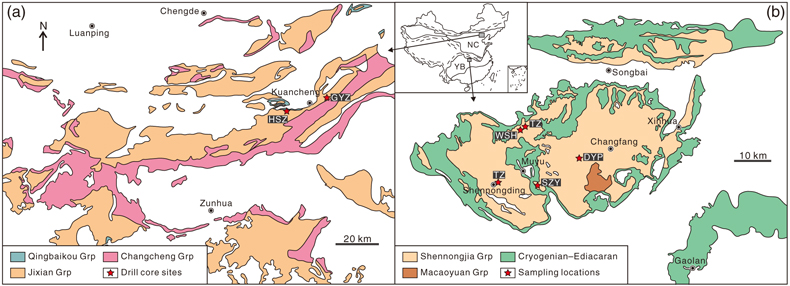
Figure 1 Maps showing the Proterozoic outcrops in the (a) Yanliao and (b) Shennongjia regions. Sampling locations are marked as stars. Formations: GYZ, Gaoyuzhuang; HSZ, Hongshuizhuang; DYP, Dayanping; TZ, Taizi; WSH, Wenshuihe; SZY, Songziyuan.
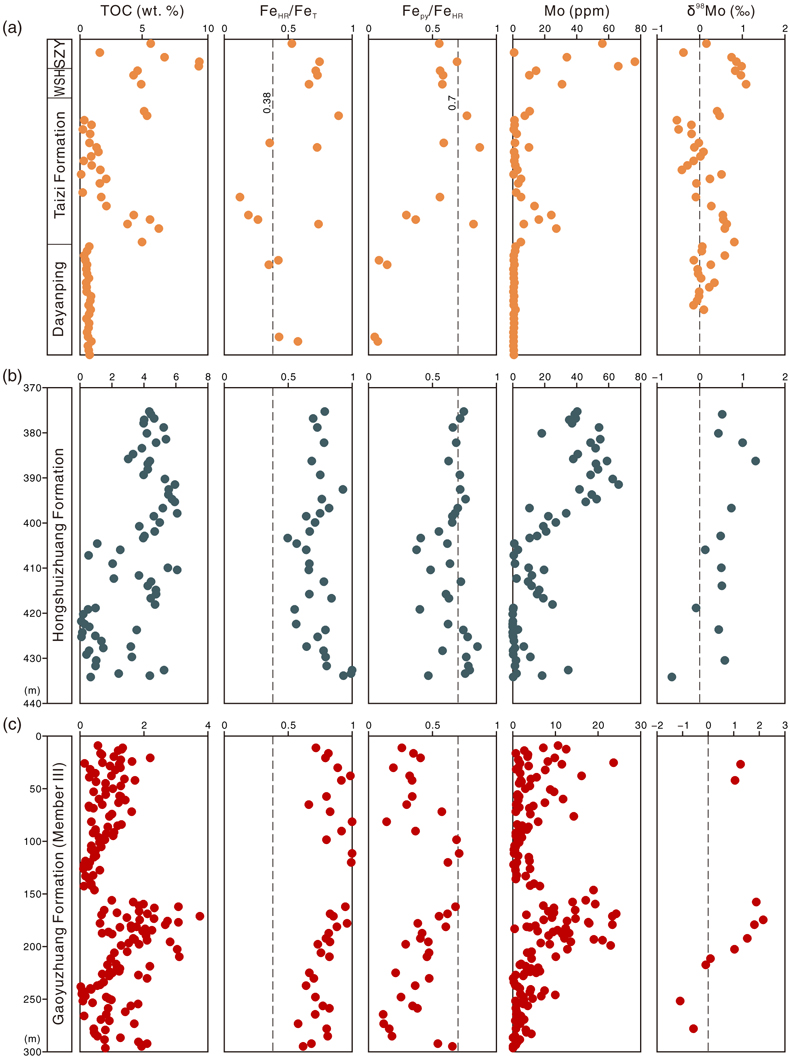
Figure 2 Geochemical profiles for shales from the (a) Shennongjia Group, (b) Hongshuizhuang Formation, and (c) Gaoyuzhuang Formation (Member III). The TOC and Mo contents of the Shennongjia Group are compiled from Canfield et al. (2018)
Canfield, D.E., Zhang, S., Frank, A.B., Wang, X., Wang, H., Su, J., Ye, Y., Frei, R. (2018) Highly fractionated chromium isotopes in Mesoproterozoic-aged shales and atmospheric oxygen. Nature Communications 9, 1–11.
. Note that the Shennongjia samples are plotted sequentially and relative to stratigraphic position, but not as a function of depth.
Figure 3 Black shale Mo record. (a) Mo isotope ratios from the Palaeoarchean to present. (b) Filtered data in 100 million year bins, focusing on samples with δ98Mo greater than the continental crust composition (>0.3 ‰). The Box and Whisker plots show the first quartile, mean (white lines), median (black lines), third quartile, and outliers of the data. (c) Mo concentrations through time.

Figure 4 Estimates of ocean redox through the Mo isotope mass balance model, where Aox, Ainter, and Aeux denote the seafloor areas of oxic, intermediate reducing, and strongly euxinic conditions, respectively. The left panel (a) is based on a fractionation of 0.7 ‰ for the intermediate sink, while the right panel (b) employs a larger fractionation of 1.5 ‰ for this sink.






